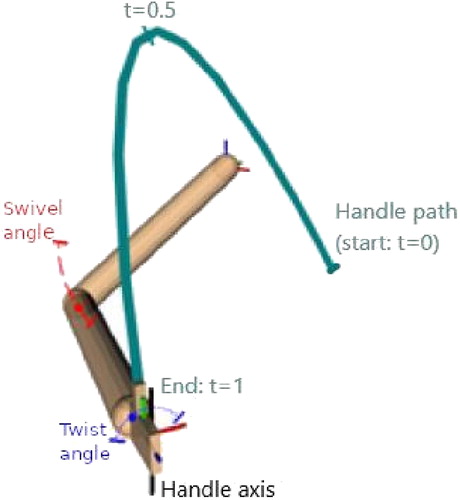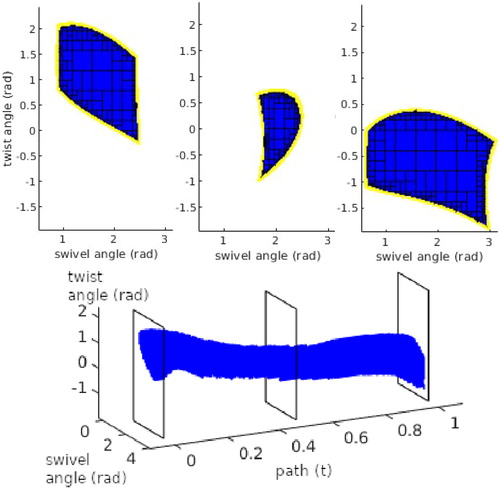1. Introduction
Robots will soon routinely collaborate with humans through cobots that assist the human operator’s movements. Consequently, several challenges arise concerning the ergonomics of these devices as they may limit the operator’s freedom of movements and, due to gestural adaptation or stereotypic movement patterns, induce increased fatigue and musculoskeletal disorders that they are supposed to suppress. In order to take these issues into consideration, the starting point is a sufficient understanding of the variabilities and associated kinematic redundancies of a group of human operators for a predefined task. A robot’s design and behavior must be adapted to a range of human operators varying in anthropometric characteristics, strength and expertise to make collaboration more effective. Any proposed model should be able to represent the movement variability in a unified way considering variable morphologies of groups of human operators (Faraway and Reed Citation2007), managing uncertainties (Chiari et al. Citation2005) and joint redundancy (Latash et al. Citation2007). A novel framework relying on interval analysis, a powerful tool which allows accounting for uncertainties or variabilities associated with a kinematics chain, is proposed. This framework is applied to biomechanics for representing motor variabilities of individuals or groups of human subjects modelled as imprecise kinematics chains (e.g., different sizes and with uncertain dimensions). This allows to derive a movement spatiotemporal representation called the redundancy tube which accurately and globally describes the variabilities associated with a task.
2. Methods
Interval analysis (Moore et al. Citation2009) provides the reliable mathematical framework which allows to model bounded uncertainties and to analyse imprecise kinematic models. An interval variable [x] = {x | a ≤ x ≤ b} models bounded uncertainties and an interval extension of an equation f([x]) uses interval arithmetic operations to reliably evaluate the equation over the interval. The model is formulated using the appropriate design methodology (Merlet and Daney Citation2008) which allows bounded uncertainties (e.g., uncertainties in measurements, joint axes, etc.) to be managed. Uncertainties and variabilities are incorporated into the model by utilising interval transformation matrices to describe the transformations between joint frames. Appropriate intervals are used for the position and orientation elements to accurately incorporate each uncertainty or variability. An effective method of modelling the kinematics is described in (Porta et al. Citation2009) and is applied here. Analysis methods based on interval analysis reliably determine the performance of the imprecise kinematic model.
As a working example, the redundancy tube framework is used to study the human upper-limb modelled as a 7 degrees of freedom (dofs) imprecise kinematic chain (3 dofs at the shoulder, 1 at the elbow, and 3 at the wrist). The task considered is a hand grasping a passive handle moving along a path with a fixed handle axis. The handle path is given by parametric equations describing the handle pose in terms of the parameter t. The task has two redundancies as seen in : 1) the swivel angle (i.e., elbow range-ofmotion), and 2) the handle twist angle (i.e., wrist range-of-motion). For a given handle pose t, the considered individual or group of individuals have a set of valid swivel and twist angles (i.e., the redundant workspace), which satisfy the considered shoulder, elbow, and wrist anatomical constraints (Wang et al. Citation1998; Gehrmann et al. Citation2008; Kane et al. Citation2014).
Figure 1. The upper-limb at a given pose showing: the elbow swivel angle, the handle twist angle, and the handle path.

As the handle moves along the path, the union of the redundant workspaces from each pose creates the redundancy tube. An important property of the redundancy tube is that it describes the complete range-ofmotion of the upper-limb along the path. The set of individuals who are described by the imprecise kinematic model will always generate motions inside the redundancy tube. Thus, the redundancy tube provides a useful new tool for studying the motor-variability of individuals and groups.
3. Results and discussion
A redundancy tube is generated for the handle path and upper-limb shown in which describes the range-of-motion of the upper-limb along the path. The redundancy tube and several slices are given in . The blue regions returned by the analysis algorithm are guaranteed to be inside the redundancy tube, while the yellow regions, by necessity, are unclassified and separate inside and outside regions. Near the start and end of the path the individual has many available motions, whereas near the centre of the path there are few available motions. How an individual repeatedly moves along the path and how they transition to/from more constrained regions may provide insight into their level of fatigue, expertise, etc. (Srinivasan and Mathiassen Citation2012).
Figure 2. (Top) Slices of the redundancy tube (i.e., redundant workspaces) at the start (t = 0), middle (t = 0.5), and end (t = 1) of the path. (Bottom) Redundancy tube of the modelled upper-limb along a path.

This work is a preliminary study and develops the redundancy tube framework which is needed in order to study motor variabilities. Experimental work is ongoing to improve the accuracy of anatomical constraints, to validate the redundancy tube of an individual, and to study an individual’s motorvariabilities for a specific task. An individual’s use of their variabilities, during repeated executions of a task, can be tracked and analysis of the individual’s motions within their redundancy tube may reveal certain indicators which may be used to improve human-robot collaborations.
4. Conclusions
A new reliable framework for interpreting the capabilities of individuals and groups is presented. An important application of this work is to better understand motor-variability and to enable more effective human-robot collaborations. Furthermore, the framework allows to study concepts such as ergonomics, dexterity, and force-capabilities by applying mappings to the redundancy tube, which provide additional avenues for improving collaboration.
References
- Chiari L, Croce UD, Leardini A, Cappozzo A. 2005. Human movement analysis using stereophotogrammetry: part 2: instrumental errors. Gait Posture. 21(2):197–211.
- Faraway J, Reed M. 2007. Statistics for digital human modeling in ergonomics. Technometrics. 49(3):277–290.
- Gehrmann SV, Kaufmann RA, Li ZM. 2008. Wrist circumduction reduced by finger constraints. J Hand Surg. 33(8):1287–1292.
- Kane PM, Vopat BG, Got C, Mansuripur K, Akelman E. 2014. The effect of supination and pronation on wrist range of motion. J Wrist Surg. 3(3):187–191.
- Latash ML, Scholz JP, Schöner G. 2007. Toward a new theory of motor synergies. Motor Control. 11(3):276–308.
- Merlet JP, Daney D. 2008. Appropriate design of parallel manipulators. London: Springer, p. 1–25.
- Moore RE, Kearfott RB, Cloud MJ. 2009. Introduction to interval analysis. Philadelphia (PA): SIAM.
- Porta JM, Ros L, Thomas F. 2009. A linear relaxation technique for the position analysis of multiloop linkages. IEEE Trans Robot. 25(2):225–239.
- Srinivasan D, Mathiassen SE. 2012. Motor variability in occupational health and performance. Clin Biomech. 27(10):979–993.
- Wang X, Maurin M, Mazet F, Maia NDC, Voinot K, Verriest JP, Fayet M. 1998. Three-dimensional modelling of the motion range of axial rotation of the upper arm. J Biomech. 31(10):899–908.
